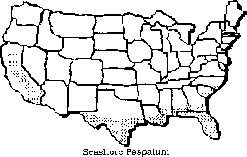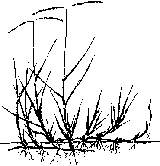 Seashore Paspalum (Paspalum vaginatum) is native to tropical and
subtropical regions of North and South America. In the United States, seashore
paspalum is found along coastal regions from Texas to Florida and North
Carolina southward. The species is also used for turf in South Africa,
Australia and New Zealand.
Seashore Paspalum (Paspalum vaginatum) is native to tropical and
subtropical regions of North and South America. In the United States, seashore
paspalum is found along coastal regions from Texas to Florida and North
Carolina southward. The species is also used for turf in South Africa,
Australia and New Zealand.Adalayd (also called Excalibre) is a selection of seashore paspalum found in Australia during the 1970's by Hugh Whiting. Adalayd is grown and distributed by Intersol in Palm Desert, California. Morris Brown of Coastal Turf in Bay City has the franchise for growing and distributing Adalayd in Texas. Glen Oak's Turf in Camilla, Georgia is a southeastern distributor.
Seashore paspalum is a warm season perennial grass that spreads by rhizomes and stolons. The stolons and leaves of seashore paspalum are slightly coarser than those of common bermudagrass. However, when mowed regularly at heights of 1° inches or less, the grass produces a dense turf. Adalayd has a blue-green color and texture similar to that of Kentucky bluegrass.

One of the outstanding characteristics of seashore paspalum is its tolerance to saline soils. It is reported to tolerate brackish sites much better than bermudagrass. Along the Texas coast the species is often the only grass found growing around brackish ponds and estuaries.
Perhaps the most extensive planting of Adalayd (Excalibre) in Texas is on the King's Crossing golf course in Corpus Christi. The entire golf course, except for the putting greens, was sprigged with seashore paspalum. Tees, fairways and roughs at King's Crossing are covered with the grass. After playing King's Crossing with J.D. Batton, the golf course superintendent, I was impressed with the appearance and playability of the grass. Perhaps most striking was the uniformity of the turf and the complete absence of other grass species.
For sure J.D. has done a great job of manicuring the golf course. But the absence of other grasses also reflects the competitiveness of seashore paspalum and its salt tolerance relative to other species. Even many of the live oak trees planted on the site are drying as a result of the salt content of the soil and irrigation water. The only bermudagrass found on the golf course was on the greens constructed of sand with underlying tile drains. It doesn't appear that Poa annua or even crabgrass will be a problem on the fairways at King's Crossing -- the salt content is too high for both species.
Seashore paspalum was found growing along the edge of the water on several holes -- water that often contained 4,000 or more ppm salts. It was also the only grass species found growing in saline outcroppings of soil along roughs and ditch banks. Its salt tolerance appeared to be great.
The quality of the turf was also very good. It was evident that the grass produced the finest turf at mowing heights below one-inch. Tees mowed at 3/8 inch were more dense and finer textured that fairways mowed at 3/4 inch. And the fairways were more dense than roughs mowed at 1° inches. Studies conducted by Texas A&M University at College Station also suggest that the grass develops higher shoot densities at lower mowing heights.
Several years ago, I observed native stands of seashore paspalum on golf greens in Argentina mowed twice daily at 1/8 inch. Under that mowing regime seashore paspalum produced as fine a putting surface as Tifdwarf bermudagrass. But more important, the grass completely crowded out stands of hybrid bermudagrass that had been sprigged on greens. The native species of seashore paspalum on the putting greens in Argentina appeared to be finer textured than Adalayd. However, that may have just been a response to the close, frequent mowing regime.